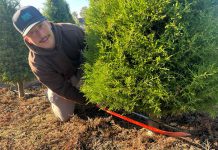Federal trappers peddle services to Santa Clara County;
environmentalists gird for fight
In a repeat of what occurred in San Benito five years ago, Santa
Clara County is contemplating signing on to a federal
coyote-killing program that benefits few but is paid for by
all.
p
>
A subcommittee of county supervisors, chaired by Supervisors Don
Gage and Pete McHugh, were slated to listen to a pitch from the
USDA Wildlife Services Thursday night during a public meeting in
San Jose to consider whether to buy the agency’s trapping
services.
Federal trappers peddle services to Santa Clara County; environmentalists gird for fight
In a repeat of what occurred in San Benito five years ago, Santa Clara County is contemplating signing on to a federal coyote-killing program that benefits few but is paid for by all.
A subcommittee of county supervisors, chaired by Supervisors Don Gage and Pete McHugh, were slated to listen to a pitch from the USDA Wildlife Services Thursday night during a public meeting in San Jose to consider whether to buy the agency’s trapping services.
The federal trappers use controversial methods considered inhumane and unnecessary by environmentalists and animal rights groups, and include the use of indiscriminate neck snare traps that kill thousands of untargeted animals, clubbing of coyote pups and lethal “smoking” of coyote family dens with carbon dioxide cartridges.
Until 2001, San Benito County used the same services of two federal trappers to annihilate the area’s coyote population, ostensibly to protect ranchers’ livestock. Though no environmental study on the problem had ever been attempted, and while no ranchers had reported any cattle killings to the local Fish and Game office, the trappers killed nearly 3,000 coyotes and their pups a year in the county – the highest reported for any county in the state.
But since squirrels and rodents, say biologists, are the main staple of the coyote diet, the extermination caused an explosion in the ground squirrel population, which has proven to be more deadly to cattle than what the coyotes did. The ground squirrels burrow in pastures, which cause stock to stumble in the holes and go lame, in addition to having to compete with the rodents for pasture grass.
At that time it cost San Benito taxpayers $60,000 a year for the USDA trapping, with half the cost offset by a reimbursement of state gasoline tax to the county – also provided by taxpayers statewide. Public outcry brought the subsidy to an end, but last year San Benito’s ag commissioner hinted that a group of ranchers and farmers re-contracted the trappers on a private basis. He would not elaborate when pressed for details.
Already, the same proposition which would target wildlife mostly in the rural areas surrounding Gilroy, Morgan Hill and the Mount Hamilton range has stirred a loud opposition from local pro-wildlife groups such as Little Blue Society, a nonprofit organization based in the South Valley, which works to resolve human-animal conflicts in the region.
“People are always looking for government to provide all these services to them,” said Henry Coletto, director of LBS’s program implementation and Santa Clara’s former game warden of 35 years. “In the old days the rancher would take care of any problem himself but today they seem to be too lazy to do that.”
For years, a statewide law has been in effect which allows people to shoot coyotes or any other “varmints” such as ground squirrels on their property, at any time.
And like San Benito, Santa Clara officials are considering the same lethal program without any ecological studies showing that coyotes are a major problem for ranching. In Santa Clara’s case, officials of its Vector Control District are using different tactics: a fear of rabies; and the argument that the county could save money in destroying “nuisance wildlife” by giving the job to the federal trappers. Vector Control’s goal is to control disease in the area, such as West Nile Virus carried by mosquitoes.
It is not clear how paying federal Wildlife Services would save the county money, but the argument against rabies is a weak one.
In a proposal to the county, ag director Greg Van Wassenhove cites three incidents of nuisance wildlife throughout the county, which occurred throughout April and May. In one case, three skunks were under a Morgan Hill house, and in another two opossums were living under a San Jose home. Vector Control trapped the animals and had them killed through Animal Control. All tested negative for rabies.
In another incident, Vector Control caught three coyotes and one coyote pup in leg-hold traps after they were caught sunning themselves near someone’s backyard pool in Saratoga. Apparently, the resident had left pet food on his porch. All the coyotes were killed and, again, tested negative for rabies.
Van Wassenhove’s report comes with several lists of rabies activity from “nuisance wildlife” in the county dating back to 2003 – or rather, non-activity. Of the hundreds of mammals Vector Control killed in the last three years, only one skunk tested positive for rabies back in 2003. Over the course of four years, four bats also tested positive.
Vector Control spokesperson Chris Costa was not available for comment as of deadline, and neither was Van Wasserhove.
Coletto and colleague Mary Paglieri, director of Little Blue Society, believe that monetary considerations do not take precedence over “our moral and ethical obligations,” Paglieri said.
“Vector Control has no business dealing with wildlife,” Paglieri added. “They view these animals as bags of diseases. Every animal they trap at people’s homes they kill, instead of re-releasing them within a two-mile radius as authorized by the state Fish and Game. They even kill the babies.”
Paglieri finds it ironic that the county’s Vector Control would want to hire federal trappers to eliminate needed “keystone” predators such as coyotes which keep disease-carrying rodent populations in check.
“When they killed most of the coyotes in San Jose and Almaden Valley, people started complaining that rodents were getting into their walls,” Paglieri said.
Paglieri and Coletto are hoping the county takes a more educational approach, and use the methods their organization does to teach people how to humanely discourage wildlife from invading their properties. Little Blue Society documents a long list of successes in that regard.
Melissa Hippard, director of the local Loma Prieta Chapter of the Sierra Club, agrees that the best balanced ecosystem is one that gets there naturally.
“When humans get involved, we tend to impact that equilibrium,” Hippard said. “By just eliminating coyotes, you end up with negative impacts like booming squirrel and rodent populations. It’s a species related to many other species.”









